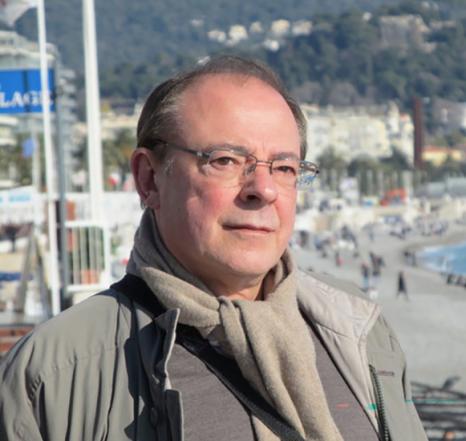
Bertrand Poumellec: using light for the in-depth sculpting of material
Bertrand Poumellec is a chemist and Research Director at the Molecular Chemistry and Materials Institute of Orsay (ICMMO - Univ. Paris-Saclay, CNRS) and co-founder of the interdisciplinary structure, the Integrative Institute of Materials (2IM) at Université Paris-Saclay. A specialist in the optical properties of transparent materials, at the interface between solid-state chemistry and physical properties, for over 30 years he has been interested in the creation or transformation of these properties by light.
Bertrand Poumellec entered the École Normale Supérieure of Saint-Cloud in 1976 to study physical sciences with the intention of working on waste recycling. However, he soon shifted his focus to chemistry, obtaining his teaching qualification (agrégation) in 1979. His diploma of advanced studies (DEA) internship was dedicated to the plastic deformation of olivine, a magnesium-iron silicate crystal and a major constituent of the Earth's upper mantle. Then in 1981, he defended his first thesis in geophysics on the deformation of materials. In the same year, he joined the CNRS' Laboratory of thermodynamics and physical-chemistry of materials (LPTCM). Here he wrote his doctoral thesis on the physical properties of rutile, a mineral species composed of titanium dioxide in nature and, for this study, also of tantalum, niobium and vanadium. "I was interested in the structural, thermodynamic, magnetic and conductivity properties of these materials, which led me to study their point defects," explains the researcher.
With Alcatel, exploring optical fibres
Curious to explore the world of industry, after completing his thesis in 1986, Bertrand Poumellec decided to take his career in a new direction. In 1987, he asked for a sabbatical year and joined Alcatel's rapidly expanding laboratory in Marcoussis (91). "There, I discovered another research field - that of the optical properties of optical fibres - full of potential for innovation and development. This sabbatical turned into a collaboration lasting nearly thirteen years, during which time I became interested in the development of optical fibres and optimising their manufacturing process." During this period, he developed and further researched a new approach that gradually fuelled all his work and experiments, eventually becoming his central research theme: the use of light to transform the optical properties of glass.
Infrared and second harmonic generation
"When I joined Alcatel, I became interested in the spontaneous second harmonic generation in fibres, in other words, the power of optical fibres to double the frequency of light, which is normally impossible for a material with a centre of symmetry. We needed to understand what could break this symmetry and transform the fibre," says Bertrand Poumellec. This work led to international collaborations with researchers from Moscow, Riga and Southampton, and highlighted the fact that the nonlinear interaction of infrared light with the fibre's glassy material produces an asymmetric distribution of point defects, resulting in frequency doubling. "This was an important breakthrough, ushering in a new era for fibres insofar as these newly induced properties can be used to transport and process information carried by light."
Ultraviolet and changes in the refractive index
"After these initial studies using infrared light, scientists realised that ultraviolet light also enables matter to be transformed," continues Bertrand Poumellec. Among these structural transformations induced by the absorption of UV light, the researcher was particularly interested in the local densification of the material, leading to a change in the refractive index. And with good reason; when a beam of light is directed onto a material, if it is not orthogonal to the surface, the light is deflected towards higher refractive indices. "By increasing the refractive index locally, we can dictate the path followed by light within the material, thus creating waveguide-like structures, not in fibres but in glass plates used to make optical circuits."
Towards the creation of models
By using light to transform the optical properties of materials, Bertrand Poumellec has helped to create potentially-useful devices for industry. "However, for industry to adopt such devices, we needed to ensure their lifespan. We therefore began working on developing a model for their temporal evolution over 25 years, in particular in relation to their operating temperature." To make this work feasible in a laboratory, the approach involved increasing the temperature over a short period of time and projecting the data over 25 years. "Working with Pierre Niay from the University of Science and Technology in Lille, we modelled the behaviour of these devices and proposed an approach for determining their stabilisation conditions, in order to provide manufacturers with a guarantee that these devices would not lose more than 3% of their efficiency over 25 years."
Educating a new generation of engineers
In the early 2000s, with the acceleration of optical fibre technology, research programmes on light-induced transformations of the optical properties of materials multiplied across Europe. "I then had the opportunity to take part in several European programmes and to coordinate a project from 2000 to 2005 - the Optical Devices Using Photosensitivity in their Elaboration (ODUPE) project of the Human Potential in Mobility Research Training Network (RTN) programme. This project involved researchers from eleven European universities across various disciplines: glass chemistry, structure of point defects, control of physical properties, creation of devices, etc. The aim of this educational partnership was to educate future engineers in these fields about these multidisciplinary issues, so that they would have a broad view of them."
Transformations induced by femtosecond laser
From 2007 onwards, Bertrand Poumellec turned his attention to the transformations induced by femtosecond lasers, the use of which was starting to gain traction. "Together with my colleague from Southampton, who demonstrated the creation of a nanostructure that can be oriented with light polarisation, we showed that it is possible to impart force to light," explains the researcher. These results led him to introduce a new research field based on the idea that, beyond its energy-ball effect, a light pulse has a physical property capable of orienting certain structures. "I have therefore demonstrated the orientation of nanocrystals, particularly lithium niobate, with light polarisation. I believe that the future will show we can shape light to sculpt matter without physical contact."
The Integrative Institute of Materials: an interdisciplinary programme
Alongside these research activities, Bertrand Poumellec has always harboured the idea of creating a Materials Institute where an interdisciplinary community would focus not only on the creation of materials, but also on their future and impact on society. This vision has now been achieved with the establishment of the interdisciplinary programme Integrative Institute of Materials (2IM) at Université Paris-Saclay, which he co-directs. "It seems more urgent than ever, as we work on the creation of plastics or lithium batteries, to be aware of the issues associated with the development of these materials and to question their future together," stresses the researcher in conclusion.

